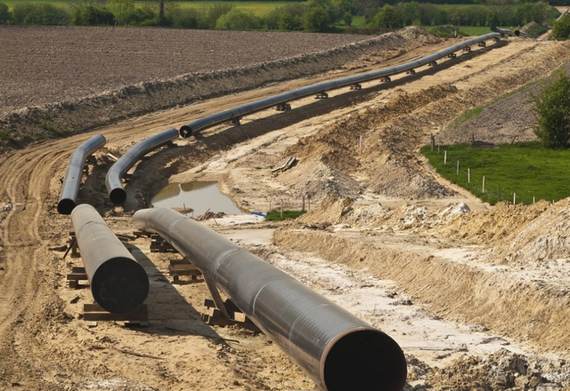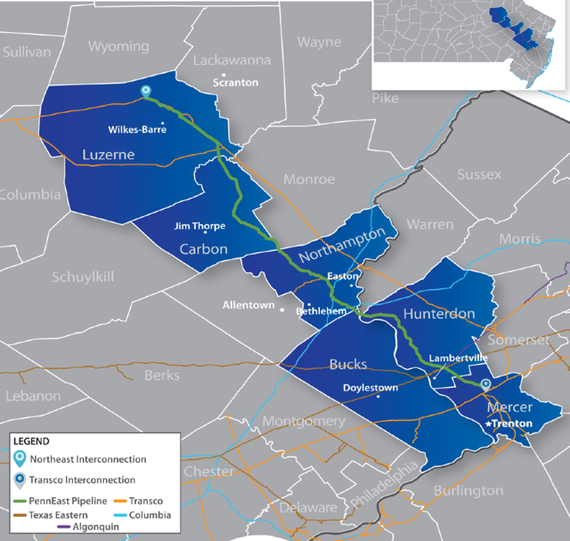by Joy E. Stocke & Kim Nagy
The Delaware is the longest undammed river east of the Mississippi, flowing for 330 miles as it travels from New York State, through Pennsylvania, New Jersey, and Delaware to the Atlantic Ocean.
The Delaware River Keeper Network
"Have you heard about the pipeline?"
From the Marcellus Shale in the Appalachian basin in Pennsylvania, where the fracked gas boom is in full force, to Trenton, New Jersey, just south of Washington's Crossing--where, on December 25, 1776, General George Washington and his troops made their famous crossing and launched the Battle of Trenton--the question moved from neighbor to neighbor in the communities along the pristine upper reaches of the Delaware River, one of the healthiest watersheds in the United States.
Rumor became fact on August 12 when a consortium of companies including utility giants UGI, AGL Resources, and NJR Pipeline Company, calling themselves PennEastPipeline Co., LLC, announced that they are seeking Federal approval to launch a one-billion-dollar project to build a three-foot (36 inch) diameter pipeline with easements of one hundred feet across (equal to a third of a city block) to run from the Marcellus Shale through wetlands, farmland, and preserved open space with a projected start date of January, 2017.
Says the Marcellus Drilling News website, "It didn't hurt that the consortium had already reserved nearly half of the billion-cubic-feet-per-day capacity for themselves!"
PennEast began putting together their plans to create a consortium to transport Marcellus Shale gas in 2011, shortly after New Jersey Governor Chris Christie unveiled the state's Master Energy Plan with a goal of bringing more sources of natural gas to New Jersey.
"The PennEast Consortium is building an empire on land that was preserved with Pennsylvania and New Jersey taxpayer dollars for the health and wellbeing of our children and for use by all citizens," says Alix Bacon, manager of the Western Piedmont Region for the New Jersey Conservation Foundation.
Natural Gas Pipeline Construction
On November 4, 2014, New Jersey voters approved Public Question #2, which proposed changing the constitution of New Jersey so that a percentage of the corporate business tax be permanently allocated to fund open space, farmland and historic preservation programs.
"By targeting preserved lands," adds Bacon, "the proposed PennEast pipeline subverts the will of New Jersey voters and flies in the face of New Jersey's 50-year-old preservation policies and programs."
According to PennEast, the pipeline will stretch 108 miles, 87 percent of which will be within the boundaries of the Delaware River watershed, with a plan to transport roughly a billion cubic feet of natural gas per day to residents in Pennsylvania and southern New Jersey. With new partner, Spectra Energy, owner of the General Partnership of DCP Midstream Partners, LP, the PennEast consortium will have the opportunity to access Cove Point, a terminus on the Atlantic ocean in Maryland, where gas could be exported to markets outside the U.S. The PennEast project also includes siting and construction of multiple high-powered compressor stations at intervals along the line.
Proposed PennEast Pipeline Route
PennEast has claimed at meetings in local communities that their intention is to provide much-needed gas to customers in South Jersey and Southeastern Pennsylvania, and not for export. But partner Spectra plans to send natural gas to export facilities, according to Williams Partners, part of the Spectra Consortium. In Williams's 2014 first quarter report, CEO Alan Armstrong says, "We're excited about the accelerating pace of expansion projects at Transco, (and) will serve as important infrastructure for future LNG (Liquid Natural Gas) export facilities at Cove Point..."
While there are residents who support the pipeline in the six counties bracketing the Delaware river along the proposed route, the overwhelming majority, including elected officials on both sides of the river, has registered concerns. Laywers, teachers, legislators, business owners, farmers and long-term residents have turned out en masse at scheduled meetings with PennEast representatives and put forth letters and resolutions rejecting the pipeline's construction, claiming that given the ecological risks, the pipeline is redundant in furthering the Northeast's larger energy plan.
In multiple meetings with PennEast officials and communities, residents and businesses (who will not benefit from the fracked gas), have asked, "If the pipeline must be built, instead of disturbing one of the few remaining rural stretches of land in the region, why not co-locate it along existing easements?"
A Farmer's Story
Three generations of the Fulper Famly in Front of their farmhouse
Robert Fulper II, a fourth-generation dairy farmer and owner of Fulper Family Farms, established in 1909 in West Amwell, New Jersey, is one of the landowners whose property lies in the path of the pipeline.
"In the 1940s and 50s, one of the gas companies, Texas Eastern, I believe, put a pipeline through a farm I rent through the State Agriculture Development Committee (SADC)," recalls Fulper, "and I definitely see extensive damage. The pipeline generates enough heat to change the temperature of the ground. When we have a hot, dry summer, those areas get severely damaged. And when I look at one of my yield maps, in that field of 10 acres, 2.3 acres show losses--more than 20% of the field--yield drop can be as much as 30 or 40 bushels of corn. The problem is," adds Fulper, "that companies like PennEast might show concern in the beginning stages of the project, but over the years, a land owner or farmer has no right and the companies can just come in anytime and do repairs on the pipeline, causing damage to crops and ruining the soil."
Last year, without notifying Fulper, an emergency repair was made on the line that already runs through the SADC property Fulper rents. "They tore the ground up and didn't put the topsoil back. They dug up my crops and left the crops a mess, left rocks on top," he says. "The crop yield was zero. I called the SADC first. They didn't know anything about it. It took days to find out what happened. Finally, I got a little reimbursement, but not enough to cover the damage."
On October 17, after a series of meetings with townships along the pipeline route, fourteen of which called for resolutions opposing the pipeline, PennEast announced that the Federal Energy Regulatory Commission (FERC) had approved its request to initiate the pre-filing review process. According to the PennEast website: "The pre-filing process includes a formal structure for interested parties along the proposed route to provide input regarding the proposed PennEast Pipeline. It also creates the framework for the environmental analysis required of the location, design and permitting of the proposed natural gas pipeline. PennEast chose the comprehensive, multi-step pre-filing approach as a way to ensure greater stakeholder (meaning affected landowners along the route) involvement early in the project's development and to work cooperatively with the FERC staff on stakeholder outreach, as well as the technical, engineering and environmental aspects of the project before a formal application is submitted. PennEast plans to complete pre-filing and file a formal application in third quarter 2015."
"Interstate natural gas pipelines are subject to stringent review and FERC oversight," said Peter Terranova, chairman of the PennEast board of managers. "PennEast requested to use the pre-filing process because it provides an ideal framework for obtaining early input from potentially affected landowners and other stakeholders. Their input helps identify areas of concern that we can try to address from the start through the design of the project."
According to Eastern Environmental Law Center staff attorney, Alice Baker, pipeline proposals must comply with the Natural Gas Act, passed in 1938, and divides control over the natural gas industry between the federal government and the states. Under the Natural Gas Act, FERC has the authority to regulate the transportation of natural gas in interstate commerce, the sale in interstate commerce of natural gas, and natural gas companies engaged in such transport.
In order for a company to construct new natural gas facilities, FERC must issue a Certificate of Public Convenience and Necessity. FERC considers whether the applicant has made efforts to eliminate or minimize any adverse effects the project might have on existing pipelines in the market and their captive customers, and landowners and communities affected by the route of the new pipeline.
"However," says Carolyn Elefant, whose law firm focuses on FERC practice and policy, "FERC does not have jurisdiction over siting local gas pipelines used purely in intrastate commerce. Nor does FERC have jurisdiction over facilities used for production or gathering of natural gas, such as a 30-mile gathering pipeline system which would gather Marcellus Shale natural gas from wells for transport to interconnections with interstate pipelines and storage facilities."
"This," says Alice Baker, "is essentially an economic test. Only where the benefits outweigh the adverse effects on economic interests will FERC proceed to complete the environmental analysis required." Baker also warned that the PennEast consortium would have the right to exercise eminent domain and claim land along the path, should FERC approve the project.
"I thought that when I put my land into farmland preservation, I was protecting it," says Robert Fulper. "I gave up the ability to develop it and build houses. What really bothers me is that the State of New Jersey has a law that says eminent domain cannot be used on farmland. But since the pipeline is coming from Pennsylvania, PennEast is able to use federal law."
Maya van Rossum, head of the Delaware Riverkeeper Network, a non-profit organization that monitors the health of the Delaware River and its tributaries, says, "When a pipeline cuts through a community, literally nothing -- wetlands, woodlands, farms -- stands in its way. PennEast says it will restore the land to what it was before the pipeline was put in. Not only won't they, they can't."
State Representatives Join Across Party Lines to Oppose Pipeline
New Jersey representatives have crossed party lines to join the protest. On October 9, Republican senator Leonard Lance of Hunterdon County issued a press release:
My constituents are right to be concerned about the current PennEast pipeline project. After careful consideration and review, I have significant questions about the project's current path and expected use of lands under farmland preservation protection and within the Delaware River Watershed.
As someone who has lived here my entire life, I fully understand how important open space and farmland preservation are to the residents of Hunterdon County and surrounding communities. I have sponsored legislation in the Legislature to protect and preserve these open spaces.
It is my hope that PennEast Pipeline company representatives will reexamine the project's proposed path and work with New Jersey's two U.S. Senators, the congressional delegation, state and local elected officials as well as concerned citizens in presenting a new plan that protects property rights and preserves public and private lands."
A week later, on October 16, Democratic congressman Rush Holt sent a letter to Kimberly D. Bose, Secretary of the Federal Energy Commission, requesting
"a full review and comprehensive assessment of the potential impacts and need for this project. It is absolutely essential that the review of this project takes into account the input of all concerned citizens and affected communities...Considering that this will be a new pipeline spanning approximately 108 miles and crossing multiple states and water bodies, an Environmental Impact Statement (EIS) should be required as part of the review of this project...The EIS should consider an analysis of project alternatives, including a "no action" alternative."
"We need to address how we as a country are going to ensure affordable heat and electricity for all," says Carina Sayles, who chose to preserve 213 acres of her 220 acre Hunterdon County family farm through the state agricultural program, with taxpayer dollars from the state, county and her township. "But as a third-generation farm owner whose preserved land is threatened by the pipeline, I was turned down when I wanted to put solar panels in my field because the state said it would be an eyesore. It makes no sense. Instead, a consortium of companies will come, rip up my land, lay down pipes and create an easement where in the future they can rip the land up again and lay down more pipes."
Delaware River Basin Commission Requests a Full Review from PennEast
On November 17, residents along the pipeline route received good news. After responding to multiple requests by the Delaware Riverkeeper Network, supported by hundreds of letters from individuals, the Delaware River Basin Commission (DRBC), tasked by the federal government with protecting states that border the river, determined that the PennEast Pipeline Project would be subject to DRBC jurisdiction and will need to obtain a docket before it can proceed with its plans.
DRBC Executive Steve Tambini wrote: "...based upon our internal review of recent submittals by the project sponsors to the DRBC and other agencies, we have advised the sponsors that the project is subject to review...The PennEast project sponsors have been requested to submit an application to the DRBC and to request a pre-application meeting."
According to the DRBC, the PennEast Pipeline "triggered" a project review after raising concerns in three areas: water withdrawal, discharge of testing water, sending pipelines in, on, under or across an existing or proposed recreational area or reservoir" designated in the agency's comprehensive plan.
As for Robert Fulper, fresh off a seven-day-a-week harvest work jag on their newly solar-powered farm, the plan is to continue to tend their herd of dairy cows, and sell milk and cheese.
"I treat my land like I treat my kids. I'm an environmentalist, but I'm a realist, too. I know it's a balancing act. I'm concerned for farmers throughout the state, who supply all kinds of crops for our food supply. And I have concerns about energy for the future of our country and that we pursue using more renewable energy whenever possible."
Along the Delaware River Basin, residents, like Fulper, are waiting to see what happens next.
Delaware River at Pralls Mill, New Jersey
Correction: Instead of Point Pleasant, New Jersey, Cove Point is in Maryland.






